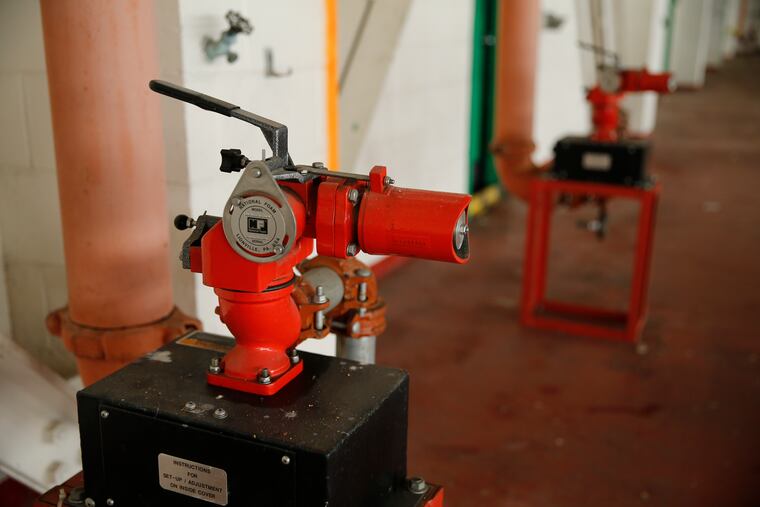How the Philadelphia region should navigate its troubled waters | Opinion
We had been blissfully unaware that chemicals from firefighting foams used at nearby military bases had leaked into our water supply for decades. We drank up the good life, not realizing the water was toxic.

When risky romaine lettuce, faulty air bags, and dangerous toys threaten our safety, public and private authorities spring into action to take these perils off the market. But protective action is not so fast when it comes to our most basic need of all: water.
Many of us in communities dotting the country learned from concerned neighbors and recent news accounts that our drinking water is contaminated with human-made perfluoroalkyl and polyfluoroalkyl substances. Collectively called PFAS, these chemicals have been tentatively linked to cancer, high cholesterol, and other medical problems.
Previously, we were blissfully unaware that chemicals from firefighting foams used at nearby military bases had leaked into our water supply for decades. We drank up the good life, not realizing the water was toxic.
Now that we are facing this multifaceted mess, it is incumbent upon regulatory authorities to set an enforceable PFAS standard that protects the drinking public — that is, everyone. Vulnerable and hardy populations, children and adults, Republicans and Democrats alike all consume water.
» READ MORE: N.J. is first state to regulate toxic PFNAs in drinking water
In my neck of the woods in Upper Dublin, just north of Philadelphia, PFAS can be traced to the military facilities in neighboring townships. Earlier this month, a pilot project revealed above-average levels of PFAS in the bloodstreams of randomly sampled residents of Horsham, Warminster, and Warrington. At a public meeting to explain the test results, the Pennsylvania Department of Health stressed that much is unknown about the adverse health effects of PFAS — and will remain that way until larger-scale studies are conducted.
My neighborhood’s water provider dealing with this unwelcome souvenir from the Department of Defense is Aqua Pennsylvania. Amid public pressure, the company has begun the time-and-money-consuming process of installing heavy-duty filters on its most tainted systems.
Yet no law currently requires Aqua Pennsylvania or any other utility to rid these wells of PFAS. In 2016, the federal Environmental Protection Agency put forth a health advisory limit of 70 parts per trillion in the drinking water — a mere guideline. But even if that de facto standard for exposure to an exceptionally durable class of chemicals had regulatory teeth, it has run into sharp criticism from the scientific community.
A number of scientists, along with lawyers, environmental stewards, politicians, and residents, clamor for mandatory PFAS removal down to thresholds as low as the gold standard of zero tolerance, referred to as non-detect.
Indeed, a recent study by the federal Agency for Toxic Substances and Disease Registry (ATSDR) showed that the EPA safety boundary is anything but. The ATSDR recommended drawing the line at a level roughly seven to ten times lower than the EPA’s suggestion. This “potential public relations nightmare,” as one White House staffer described the report, was so damning that the White House, EPA, and DOD initially tried to prevent its publication.
In the absence of a national maximum contaminant level, more and more states are starting to lay down their own laws. Some — like New Jersey, which outpaced the EPA by establishing a stricter standard for one of the most toxic PFAS compounds — are in the vanguard, while others, like Pennsylvania, have largely been treading water.
Pennsylvania has yet to pass legislation on PFAS. so hopes turn toward the overdue PFAS Action Team, which was convened by the governor in September and held its first public meeting in November. Ideally, the team will place standard-setting at the top of its agenda.
With the science still emerging, it is not clear where PFAS falls on the spectrum from concerning to catastrophic. What is clear is that the federal government, along with state counterparts, needs to speed up its efforts.
As comforting as it is that the EPA hosted a national leadership summit on PFAS last May and visited a few of the hardest-hit communities including Horsham over the summer, the pace of progress appears to be lagging. The agency promised a PFAS management plan by the end of 2018. But year-end came and went, and the EPA missed its own deadline.
Informed residents are in no mood to wait. These emboldened activists demand answers at public meetings, contact their representatives, and travel to Harrisburg — all in the valiant effort to advocate for clean water. Some customers are employing self-help measures, but those come at a cost. In my community, more residents are buying bottled water, and a few have even installed a home filtration system costing $1,500 or more. But plenty either cannot or choose not to take on those financial burdens. And many still have no inkling that they are in hot water.
This water contamination problem is not unique to Upper Dublin. Nobody in the hundreds of affected communities nationwide wants to decipher reports, explore legal options such as class action lawsuits or payments in escrow, test their water and blood, or await the scary results of long-term research pending anecdotal reports of illnesses. All that residents actually want is to drink safe water.
For that to happen, government officials must act with alacrity to set a compulsory and scientifically sound PFAS standard. Until then, awash in contaminants, we will navigate troubled waters.
Jan Zauzmer is an opinion writer who drinks PFAS-contaminated water in Upper Dublin Township. @JanZauzmer